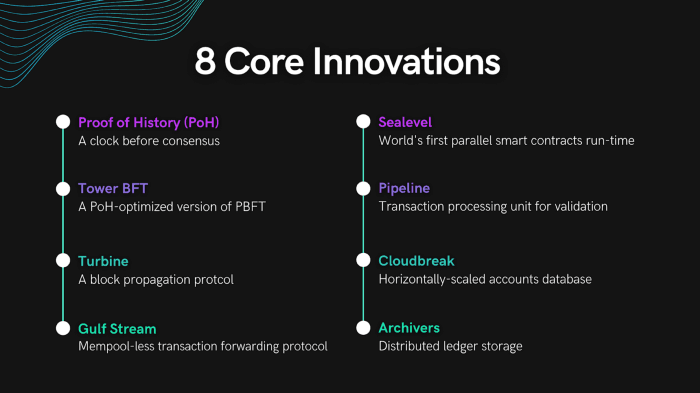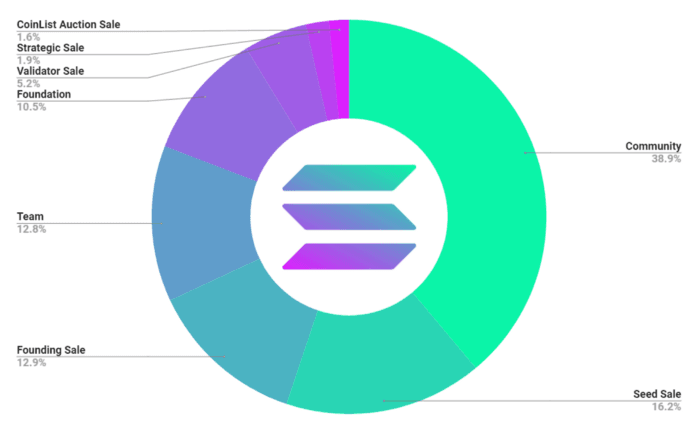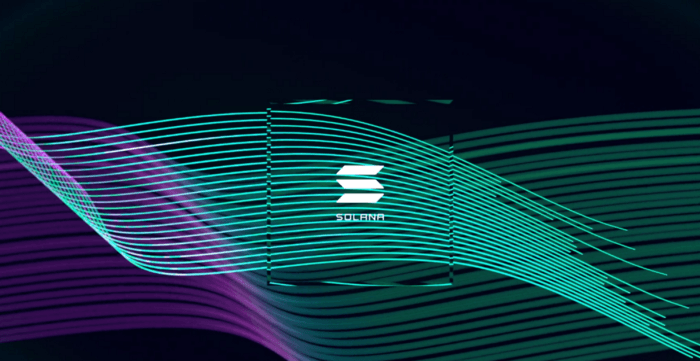The Solana ecosystem: An Introduction
Scaling issues have been plaguing blockchain platforms for years now. Layer 1 blockchains such as Ethereum haven’t been able to keep up with the numerous decentralized applications being built on them since they are just not scalable enough, which renders the networks congested and lagging. Additionally, after 2020 being named the year of the DeFi, as more and more users keep joining the DeFi space, network fees do also continue to go up and transactions are taking more time to be processed because the platforms are having a hard time scaling. This is where Solana comes in.
Solana is one of the newer blockchain platforms, with the objective to bring scalability without tampering with the decentralization or security aspects of a traditional blockchain. At the moment, the high-speed, high-throughput, Proof-of-Stake Solana ecosystem facilitates the peak capacity of 65,000 TPS (transactions per second) and a block time of 400 ms. The Solana ecosystem is made to scale together hardware and bandwidth improvements, that too with a capacity that is expected to double every other year. The native token of the Solana platform, or the Solana crypto, is called SOL.
In this post, we give you a detailed review of the Solana ecosystem.
The Solana Ecosystem: Background
The Solana ecosystem was developed back in late 2017, when founders Anatoly Yakovenko and Raj Gokal set out to do away with the scaling issues many blockchain platforms were facing. At that time, Yakovenko put out a whitepaper draft talking about a brand new timekeeping mechanism for distributed systems called PoH or Proof of History. With blockchains like Ethereum, scalability is hindered due to quite a few factors, one of which is the amount of time needed to reach a consensus on the order of transactions. Yakovenko’s proposed PoH consensus mechanism was aimed to automate the transaction ordering process for blockchains, allowing blockchain protocols to scale way beyond their usual capabilities.
The Solana ecosystem’s core team of developers consists of former Qualcomm, Intel, Apple, and Dropbox engineers. Aside from Anatoly Yakovenko, there’s Greg Fitzgerald and Stephen Akridge. They were co-founders of the company that would eventually come to be known as the Solana Labs. The Solana ecosystem launched on Mainnet Beta in March 2020.
The Technology Behind the Solana Ecosystem:
The Eight Core Innovations

The developers behind Solana based the platform on the notion that a whole decentralized network of nodes can match the performance of a single node if the communication between all these nodes is optimized just right. To achieve this, the Solana team came up with eight core technologies, which are the following:
- Proof-of-History or PoH: With the Proof of History mechanism, a blockchain can come up with a historical record that proves an event has occurred at a particular point in time. The PoH is a high-frequency VDF or Verifiable Delay Function, which needs a specific number of sequential steps to so the evaluation and gives an output that is unique and can be publicly verified. In simple words, what the mechanism does is apply timestamps to every transaction approval. The timestamps allow all nodes on the network to figure out the correct sequence of various events. Therefore, it can be said that the PoH mechanism acts as a cryptographic clock within the Solana ecosystem.
- Tower BFT: Tower BFT is the Solana ecosystem’s version of the PBFT, or Practical Byzantine Fault Tolerance. This Tower BFT uses the PoH mechanism as a clock before consensus so as to decrease messaging overhead and latency.
- Turbine: Inspired by BitTorrent, Turbine is a blockchain broadcasting protocol that serves to break any data into smaller parts that can then be carried over to nodes with more ease and using less bandwidth. Turbine is optimized for streaming and transmits information using UDP.
- Gulf Stream: Gulf Stream is the Solana ecosystem’s mempool management solution for a high-performance platform. A mempool is essentially a set of transactions on a blockchain which, in spite of having been submitted, have not yet been processed by the network. What Gulf Stream does is exterminate the need for this mempool. The mechanism lets the Solana ecosystem send new transactions to the validators even if all of the transactions on the current block have not been approved yet.
- Sealevel: The Sealevel system on Solana allows the development of thousands of smart contracts that can run parallelly, and can use the same protocols. Sealevel helps the Solana blockchain run smoothly and speedily.
- Pipelining: Pipelining is a technique the Solana ecosystem uses to help with the process of transaction validation; with pipelining, the network can quickly validate massive transaction blocks, while also replicating those throughout the network. So, Pipeline is Solana’s transaction processing unit to minimize the block validation time.
- Cloudbreak: Cloudbreak is the Solana ecosystem’s horizontally scaled state architecture, which helps Solana to come up with software that doesn’t get in the way of the hardware to allow for full utilization.
- Archivers: This is the Solana ecosystem’s distributed ledger storage, and this mechanism gives validators prompt access to any information they might want, like transaction histories.
Consensus Mechanism
Solana uses the Delegated-Proof-of-Stake (DPoS) consensus mechanism. Now, these are quite similar to the usual PoS blockchains, except much quicker; indeed, the Solana ecosystem only takes about 2.34 seconds to produce a new block.
On Solana, SOL holders can participate in block production and earn rewards. You can stake the Solana crypto SOL to secure either of two positions — a validator, or a delegator. A validator, as you might know, processes the transactions made on the blockchain. Validators on Solana earn the Solana crypto as a reward. However, being a validator means you must have a certain, sizable number of SOL tokens. If you don’t own that many, you can still become a delegator within the Solana ecosystem. As a delegator, you would be delegating the Solana crypto you own to a validator of your choice. This way, you can also claim a portion of the rewards the validator receives, equivalent to your contribution.
Wormhole
The Solana ecosystem, in partnership with Certus One, has created Wormhole. Wormhole is a bidirectional bridge between the Ethereum and Solana platforms. This bridge would allow users to trade between Ethereum and Solana and transform Ethereum’s ERC-20 tokens into Solana’s own SPL standard. Wormhole is helping Solana amp up its interoperability game.

Wormhole Sketch
(Image Source: Solana GitHub)
Solana Crypto Tokenomics
The Solana crypto, or SOL, is the native token of the Solana blockchain. SOL has three primary use cases within the Solana ecosystem as of right now, which are:
- Staking: As mentioned before, with the delegated-Proof-of-stake consensus algorithm, users can stake their Solana crypto directly on the network to become a validator, or delegate their holding to an active validator of their choice.
- Transaction Fees: On the Solana network, users can use their SOL tokens to pay up the transaction fees or even for running smart contracts and keeping up communications with various decentralized applications.
- Governance: Finally, the Solana crypto also acts as the network’s governance token.
The Solana team distributed SOL tokens in five different funding rounds, and four of these rounds were private sales. The private sales began in the first quarter of 2019 and ended with a $20 million Series A in July 2019. Participants included Multicoin Capital, Distributed Global, BlockTower Capital, Foundation Capital, Blockchange VC, Slow Ventures, NEO Global Capital, Passport Capital, and Rockaway Ventures. While all these companies received Solana crypto for their investments in the project, the number of SOL tokens allocated to them were never announced. In 2020, Solana had its fourth private sale and a public auction hosted by CoinList, both of which combined brought the Solana ecosystem about another $4 million. The SOL tokens remaining from the initial SOL supply went to the members of the Solana Labs, the Solana Foundation, and a community reserve.
The initial distribution of SOL tokens went something like this:
- 16.23% to the Seed Round investors
- 12.92% to the Founding Sale investors
- 5.18% to the Validator Sale investors
- 1.88% to the Strategic Sale investors
- 1.64% to the Coin list Auction Sale investors
- 12.79% to the Solana team members
- 10.46% to the Solana Foundation
- 38.89% to the community reserve fund managed by the Solana Foundation

Is Solana Crypto Worth Investing In?
In July 2020, the Solana crypto was trading at just above $1, and as it continued its upside rally, in August 2020, SOL managed to hit the $4 mark. After that, however, the Solana crypto went on a mostly flat trend until the beginning of 2021. By the end of January 2021, SOL had almost reached $4.40. And since then, as there’s been a bullish phase within the cryptocurrency markets overall, the cryptocurrency has gone over $40, even hitting the high of $58.30 on May 19, 2021. On the basis of the price of the Solana crypto at the end of June, most technical indicators suggest a bullish scenario for Solana in the times ahead.
Some Projects That Have Partnered With Solana
With Solana’s advanced technology, scalability solutions, and interoperability, it’s no wonder that a number of significant projects from within the crypto space have already partnered up with the Solana ecosystem. Here’s just a few of them:
- Audius: Audius is a blockchain-based music streaming platform that hands all power to musicians and artists. Audius’s native crypto token is AUDIO. Audius partnered up with Solana so as to scale community-owned music streaming. Solana would be helping Audius with speed, decreasing fees, and censorship resistance.
- Serum: Serum is a high-speed, non-custodial DEX, or decentralized exchange platform built within the Solana ecosystem by FTX and Alameda Research. Serum is a scalable, decentralized matching engine that can power a whole ecosystem of interconnected exchange protocols, and supports cross-chain asset swaps, decentralized stablecoins, decentralized oracles, and non-custodial wrapped tokens. Serum’s native crypto is called the SRM token.
- The Graph: The Graph is the indexing and querying protocol for the decentralized web. The Graph makes it possible for developers to create open APIs, or Application Programming Interfaces, which are known as subgraphs. The Graph supports indexing information from quite a few blockchain platforms at the moment, including Ethereum and Solana. When these subgraphs are used by someone to index and query data from one of the supported networks, the respective developers of said subgraphs earn a fee. The Graph’s native crypto coin is the GRT, upon which its incentivization mechanism is based.
- Maps.me: This platform offers an offline mapping service, that can help with things like turn-by-turn routing, travel guides, detailed mapping, and a lot more. The platform’s native token is the MAPS coin, which connects over 100 million users.
- Raydium: Raydium is an AMM (automated market maker) built on Solana for Serum. Raydium essentially acts as a bridge for the crypto projects looking to partner with Solana and Serum. Raydium’s native crypto token is RAY.
And there was all you needed to know about the Solana ecosystem, in one place. If the Solana crypto sounds like something you’d want to invest in, you can do so through our website!
